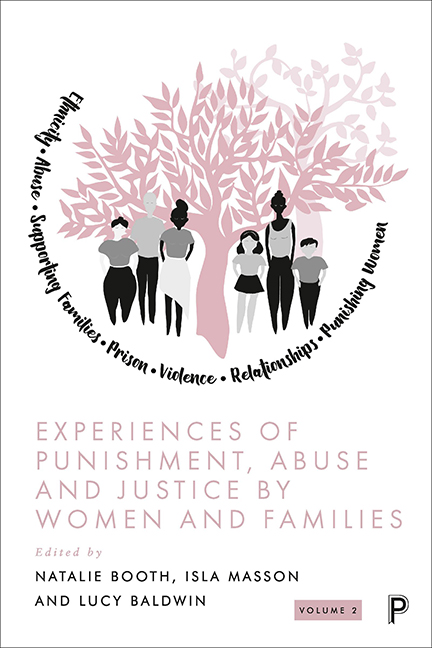Book contents
- Frontmatter
- Contents
- Notes on contributors
- Acknowledgements
- Foreword: time to shift the focus and reduce the use of the penal system for women
- 1 Keeping the conversation going: the Women, Family, Crime and Justice network
- Part I Punishing women in the criminal justice system
- Part II Violence, abuse and justice
- Index
7 - “It feels like a mini victory”: alternative routes to justice in experiences of online misogyny
Published online by Cambridge University Press: 18 January 2024
- Frontmatter
- Contents
- Notes on contributors
- Acknowledgements
- Foreword: time to shift the focus and reduce the use of the penal system for women
- 1 Keeping the conversation going: the Women, Family, Crime and Justice network
- Part I Punishing women in the criminal justice system
- Part II Violence, abuse and justice
- Index
Summary
Introduction
Online misogyny is an umbrella term, encompassing a range of behaviours occurring on the internet which demonstrate a ‘dislike of, contempt for, or ingrained prejudice against women’ (Lexico, 2021). This includes the non-consensual sharing of indecent images, or ‘revenge porn’ (Citron and Franks, 2014; McGlynn and Rackley, 2017; McGlynn, Rackley and Houghton, 2017), the receipt of graphic images, or ‘dickpics’ (Vitis and Gilmour, 2017; Tweten, 2018), cyber-stalking (Citron, 2014) and various forms of harassment (Henry and Powell, 2016; Powell and Henry, 2017; Smith, 2019). Although online abuse is not new (see, for example, Dibbell, 1993; Herring, 1999), the scale, form and reach of such abuse has expanded (Amnesty International, 2017; Vogels, 2021) as the internet has become a greater part of our everyday lives (Office for National Statistics [ONS], 2021). In some cases the abuse that targets women focuses solely on gender, but it is also clear that online misogyny intersects with other characteristics including race (Madden et al, 2018), religion (Easat-Daas, 2021; Klaff, 2021), gender identity (Colliver, 2021; Rogers, 2021) and disability (Healy, 2021).
This chapter explores a specific facet of online misogyny: online gendered hate. This term describes those acts of aggression, abuse and threatening words or behaviours which target women in online public spaces (Smith, 2019). The acts can be verbal or written, in the form of comments on social media sites, videos on YouTube or TikTok and/or can be image-based (Sarkeesian, 2014; 2015; Mantilla, 2015). It has been argued that women can experience this form of abuse directly or indirectly (Smith, 2019). Direct abuse is that which targets a particular woman and is received by them from the perpetrator (Smith, 2019), with many examples of this specific targeting evident in academic work, news articles and on social media sites (Lewis, 2011; Sarkeesian, 2014; Mantilla, 2015; Amnesty International, 2017; Line, 2017; Rawlinson, 2018; Hunt, 2019; Borowiec, 2021). Indirect abuse occurs when a woman is not herself the target of abuse, but encounters other women being subject to abuse in online spaces (Smith, 2019). This may be through reading articles or blogs about online abuse, or by these indirect recipients actually encountering other women receiving abusive messages in online spaces.
- Type
- Chapter
- Information
- Experiences of Punishment, Abuse and Justice by Women and FamiliesVolume 2, pp. 110 - 131Publisher: Bristol University PressPrint publication year: 2023



